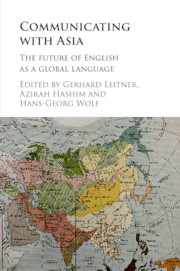Book contents
- Communicating with Asia
- Communicating with Asia
- Copyright page
- Contents
- Figures
- Tables
- Contributors
- Book part
- Communicating with Asia: introduction
- Part I English in selected regional and national habitats with a glance at the role of outward-bound communication needs
- 1 The development of English in Pakistan
- 2 English for Japan: in the cultural context of the East Asian Expanding Circle
- 3 Convergence and divergence of English in Malaysia and Singapore
- 4 Indian English prosody
- 5 Charting the endonormative stabilization of Singapore English
- 6 Arabic in contact with English and Malay in Malaysia
- 7 Preposition stranding and pied-piping in Philippine English: a corpus-based study
- 8 The Americanization of the phonology of Asian Englishes: evidence from Singapore
- 9 Postcolonial and learner Englishes in Southeast Asia: implications for international communication
- Part II Major other languages in Asia, their international status and impact on education
- Part III Wider perspectives
- Bibliography
- Index
6 - Arabic in contact with English and Malay in Malaysia
from Part I - English in selected regional and national habitats with a glance at the role of outward-bound communication needs
Published online by Cambridge University Press: 05 January 2016
- Communicating with Asia
- Communicating with Asia
- Copyright page
- Contents
- Figures
- Tables
- Contributors
- Book part
- Communicating with Asia: introduction
- Part I English in selected regional and national habitats with a glance at the role of outward-bound communication needs
- 1 The development of English in Pakistan
- 2 English for Japan: in the cultural context of the East Asian Expanding Circle
- 3 Convergence and divergence of English in Malaysia and Singapore
- 4 Indian English prosody
- 5 Charting the endonormative stabilization of Singapore English
- 6 Arabic in contact with English and Malay in Malaysia
- 7 Preposition stranding and pied-piping in Philippine English: a corpus-based study
- 8 The Americanization of the phonology of Asian Englishes: evidence from Singapore
- 9 Postcolonial and learner Englishes in Southeast Asia: implications for international communication
- Part II Major other languages in Asia, their international status and impact on education
- Part III Wider perspectives
- Bibliography
- Index
Summary
Language contact is a key component in language, social and cultural change. Contact is reciprocal although it has typically been studied from the angle of contact of English with local languages such as Malay, Mandarin, Hindi, Urdu or Tamil in South and South-East Asia. Up to the 1960s, contact outcomes were often seen as signs of the enrichment of the English language as such and were recorded in dictionaries. More recent outcomes have been seen as evidence of the localization of English and the growth of ‘Englishes’. Contact with Arabic is a different case. In Asia, Arabic has been deeply embedded in various languages habitats as a trade and religious language. It has influenced many languages which acted as carriers of Arabic influences into local languages such as Malay but also into English or Dutch. This chapter will address such issues and focus on loan words in English and Malay in Malaysia’s print media. We mention contact history but our principal interest will be contemporary outcomes. Does Arabic provide a religious-based linguistic layer in Malaysia and maybe other Islamic nations? As the role of Arabic is a neglected field of research, our chapter will add a new dimension to the study of varieties of English but also contribute to that of Malay in the region and connect outcomes with the political domain.
- Type
- Chapter
- Information
- Communicating with AsiaThe Future of English as a Global Language, pp. 85 - 101Publisher: Cambridge University PressPrint publication year: 2016
- 1
- Cited by



